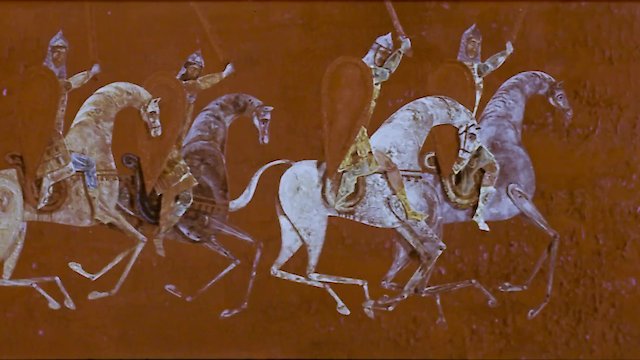
The Battle of Kerzhenets
Where to Watch The Battle of Kerzhenets

The Battle of Kerzhenets is an animated short film that was released in the Soviet Union in 1971. This fantastical piece is a unique blend of folklore, myth, and vivid imagery, presenting an interpretation of Slavic history and culture through the lens of animation. The film was directed by Ivan Ivanov-Vano and Yuriy Norshteyn, both of whom are recognized for their contributions to the world of animation. With a running time of approximately 10 minutes, the film encapsulates an entire saga into a brief yet memorable cinematic experience.
The plot of The Battle of Kerzhenets is derived from Russian folklore and depicts an epic battle between the forces of good and evil. It is inspired, in part, by the legend of the Invisible City of Kitezh—a mythical city that was said to have sunk beneath the waters of Lake Svetloyar to protect its inhabitants from Mongol invaders. According to the legend, only the pure of heart can see the city and hear the sounds of life within it. The film reimagines this legend, utilizing a conflict between opposing armies as a central narrative drive.
The animation style of The Battle of Kerzhenets is distinctive and might seem unusual to viewers accustomed to more traditional forms of cel animation. The filmmakers employed a technique akin to stop-motion, using a combination of cut-outs, paint, and other artistic elements to create an ethereal and dreamlike aesthetic. The textures and colors bring to mind ancient Russian icons and frescoes, with thick outlines and a lack of perspective that harken back to medieval art. This stylistic choice immerses the viewer in a world that feels both ancient and timeless, contributing to the overall mystique of the film.
Imagery in The Battle of Kerzhenets is striking, with landscapes that boast rolling hills, dense forests, and mystical bodies of water. Nature plays a critical role in the story, reflecting the animistic elements of Slavic mythology, where spirits and natural phenomena intertwine with human destiny. The film also showcases a heavy emphasis on the elements, with water, wind, and fire becoming compelling forces that shape the narrative.
The film's narrative structure employs minimal dialogue, relying primarily on visual storytelling to convey the plot and its underlying themes. Instead, music and sound effects play an essential role in The Battle of Kerzhenets, offering an emotional undertone to the visual spectacle. The score is heavily influenced by traditional Russian compositions, interspersed with elements of folklore music that enhance the atmosphere and give life to the characters and their actions. Choral arrangements add to the solemnity and gravity of the events depicted on screen.
Character designs in The Battle of Kerzhenets are as stylized and symbolic as the settings. The protagonists and antagonists are easily distinguishable by their appearances, with the forces of good often depicted in bright, warm colors, and the forces of evil shrouded in dark, brooding tones. Armor and weaponry are heavily ornamented, reflecting the filmmakers' meticulous attention to the cultural details of the period from which the legend originates.
While The Battle of Kerzhenets is steeped in fantasy, it resonates with the history and spirituality of Russia. The allegorical nature of the story allows for interpretations extending beyond the literal battle between knights and invaders. Some viewers may perceive the film as a commentary on the perennial fight between light and darkness, both externally in the world and internally within individuals. The filmmakers' decision to anchor the story in a cultural ethos invites contemplation of broader themes, such as the resilience of a people and the endurance of their beliefs through adversary.
As such, The Battle of Kerzhenets is not merely a retelling of a myth but also an artistic vision that celebrates and preserves Russia's rich heritage. Its non-linear narrative and abstract portrayals create a unique cinematic experience that might be quite perplexing to some viewers. However, for those with an appreciation for folklore, history, and the art of animation, the film provides an entrancing visual poem that captures the imagination and transports them to a different age.
The Battle of Kerzhenets is considered an exemplar of Soviet animation—a testament to the ingenuity and creativity of its directors and a notable piece within the pantheon of animated classics. It remains admired for its innovative techniques and its ethereal portrayal of a narrative rooted deep within the cultural fabric of Russia.
The Battle of Kerzhenets is a Animation movie released in 1971. It has a runtime of 10 min. Critics and viewers have rated it moderate reviews, with an IMDb score of 7.0..
